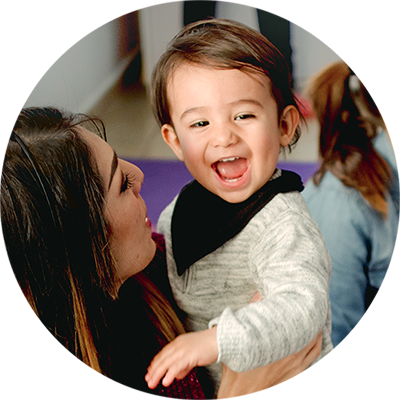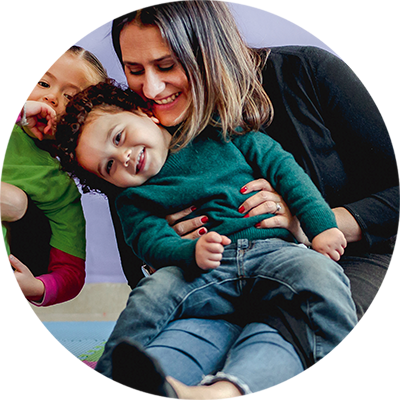Music Is for Everyone!
 Meghan, a mom of twins, watches professional soccer matches on weekends with her children. Afterwards, she often grabs a ball and takes the family to the park to play the game. “I’m inspired to run around and kick the ball after watching the pros have at it,” she says. But after Meghan and her family watch The Voice, she doesn’t leap up and belt out a song. “I see those incredible singers and I think, ‘I could never do what they do.’” Meghan is not alone. Most of us see music as something reserved for a talented few and choose to be music-watchers rather than music-makers. In reality, we are all born with the raw materials to sing and dance, just like we are wired to learn to speak and run.
Meghan, a mom of twins, watches professional soccer matches on weekends with her children. Afterwards, she often grabs a ball and takes the family to the park to play the game. “I’m inspired to run around and kick the ball after watching the pros have at it,” she says. But after Meghan and her family watch The Voice, she doesn’t leap up and belt out a song. “I see those incredible singers and I think, ‘I could never do what they do.’” Meghan is not alone. Most of us see music as something reserved for a talented few and choose to be music-watchers rather than music-makers. In reality, we are all born with the raw materials to sing and dance, just like we are wired to learn to speak and run.
Music-making is a learned skill that develops over time, through trial and error, with strong environmental support—just like other life skills. Babies are not born speaking: We talk to, with, and around babies, and they begin to babble and play with sounds. Once they start talking, children’s early attempts at language are rife with inaccuracies. We chuckle at a child’s “wrong” words and allow language to develop naturally. Can you imagine hearing linguistic errors in a toddler and proclaiming, “He’s just not going to be a talker”? Probably not, but that’s what we do with children and music.
Here’s what happens in our brains as we develop musically: Our receptive system, which allows us to “think” music, and our expressive system, which enables us to create music, develop independently. As these two systems evolve and begin to link up, we naturally learn to sing in tune and move in rhythm (i.e., develop Basic Music Competence). Early exposure to music-making with important caregivers (parents, teachers, etc.) and to a rich variety of music provides key input for the receptive system, without which the expressive system cannot develop as fully. And plentiful, safe opportunities to make music are crucial for the development of the expressive system. With support of both systems, all children can learn to understand and make music (just as they can all learn to understand and speak their native language).
Freely-chosen, spontaneous play provides deep learning opportunities for children in multiple domains, including music. Just as children will cuddle a doll and “play parent” or pick up a piece of chalk and “play teacher,” they will “play drummer” on an overturned cookpot or “play singer” while holding a pretend microphone. In so doing, they are putting their expressive system into action through developmentally-appropriate play—with no outcome in mind, no rules, and no judgement. Luckily for parents and teachers, creating an optimal early childhood music environment is easy and fun! You don’t need fancy instruments or formal lessons. Instead, sing songs from around the world together, march around the room, play tambourines and DIY drums, and music-learning will naturally occur.
 Thinking back to soccer-mom Meghan, when she kicks the ball around with her twins, she’s showing them how to play the game and modeling the desire to play. In fact, she’s teaching her children that soccer is something important enough to choose over other activities. In the same way, when parents and teachers make music with children, they are modeling the disposition to be music-makers and valuing music as a pivotal part of daily life. Interestingly, adults’ skill level in singing, dancing, and instrument-play has no effect on a child’s music development or disposition. Meghan doesn’t have to be a soccer pro to inspire her children to play the game, and she doesn’t have to be a pop star to inspire her children to sing. The more Meghan and other important caregivers (including her twins’ teachers!) sing, the more her children will sing—and want to sing.
Thinking back to soccer-mom Meghan, when she kicks the ball around with her twins, she’s showing them how to play the game and modeling the desire to play. In fact, she’s teaching her children that soccer is something important enough to choose over other activities. In the same way, when parents and teachers make music with children, they are modeling the disposition to be music-makers and valuing music as a pivotal part of daily life. Interestingly, adults’ skill level in singing, dancing, and instrument-play has no effect on a child’s music development or disposition. Meghan doesn’t have to be a soccer pro to inspire her children to play the game, and she doesn’t have to be a pop star to inspire her children to sing. The more Meghan and other important caregivers (including her twins’ teachers!) sing, the more her children will sing—and want to sing.
With strong environmental support, children will teach themselves music through experimentation and play, eventually developing into independent music-makers. This will profoundly impact their lives. They can choose to dance at weddings, sing with friends around a campfire, fully enjoy concerts and performances, and play an instrument (or not!). And, they will have access to the lifelong neural and biochemical benefits of music-making as adults. From enhancing interpersonal connectivity to supporting prosocial behavior; from supporting language development to preserving aging brain function; from increasing neural plasticity to reducing stress hormone levels—research suggests that music-making profoundly affects how we function socially, mentally, and physically.
Learning to make music—to sing, to play with instruments, and to dance, march, and twirl to songs from around the world—is a birthright for every child. We can easily support this inborn music potential by singing, playing, and dancing together. The best part is that it’s also a whole lot of fun for everyone! And then one day, when Meghan’s twins grow up, they won’t leave the music-making to the pros. After an afternoon of playing soccer with their own children, they’ll come home and sing songs at the top of their lungs while having a family dance party all around the living room. That is the gift of music we can give to our children.
References:
114th U.S. Congress (2015). S. 1177: Every Student Succeeds Act. Retrieved from: https://nafme.org/advocacy/essa/
Hallam, S. (2016). The Impact of Actively Making Music on The Intellectual, Social and Personal Development of Children and Young People: A Summary. Voices: A World Forum for Music Therapy, 16(2).
King, J. B. et al., (2019). Increased functional connectivity after listening to favored music in adults with Alzheimer Dementia. The Journal of Prevention of Alzheimer’s Disease, 6(1), 56-62.
Miendlarzewska, E.A. & Trost, W.J. (2014). How musical training affects cognitive development: Rhythm, reward and other modulating variables. Frontiers of Neuroscience, 20(7), 279.
Wolf, D. P. & Weill Music Institute (2018). Why Making Music Matters: Singing, Playing, Moving, and Sharing in the Early Years. Detroit, MI: WolfBrown. Retrieved from: https://www.carnegiehall.org/Blog/2016/01/Why-Making-Music-Matters-Music-and-Early-Childhood-Development
Author Bios:
Anne Sailer, M.A., is an Early Childhood Music Specialist who develops programs, writes curricula, and leads Teacher Training Workshops for Music Together Worldwide. She works to educate adults in communities around the world on the critical importance of live music-making in early childhood (birth through age five). Anne is also a partner in the Montclair Community PreK Early Learning Institute, leading S.T.E.A.M. music-in-the-classroom workshops for early childhood educators in the NJ-NY-CT tri-state region.
Lili M. Levinowitz, Ph.D., Director of Research, Music Together Worldwide and Coauthor of Music Together®. A Professor Emeritus of Music Education at Rowan University, Lili is a national authority on early childhood music and is actively involved in teaching very young children as well as graduate students. Her articles appear frequently in both professional journals and popular magazines. She received her Ph.D. from Temple University where she was director of the Children's Music Development Program. Through Music Together, Lili teaches Babies, Mixed Ages, Big Kids, and In School classes in Princeton, NJ.
Adapted from an article originally printed in Exchange: The Early Childhood Leaders’ Magazine, July/August 2019



